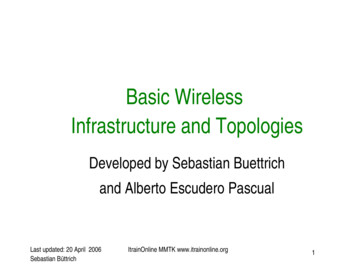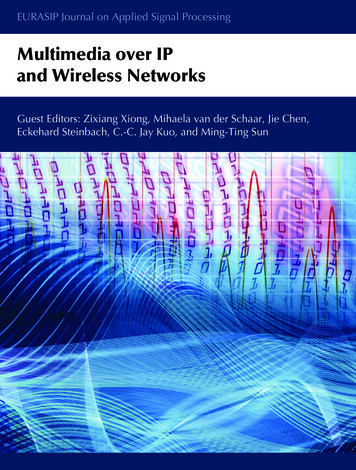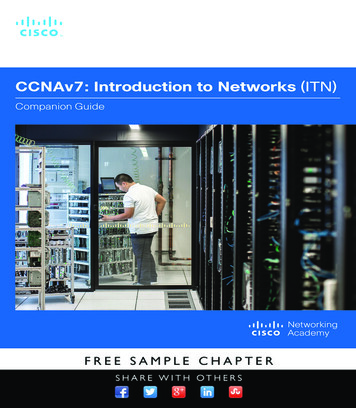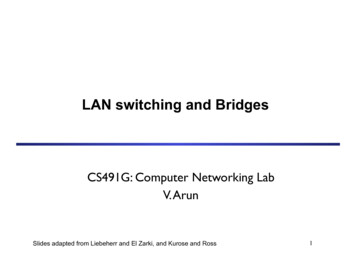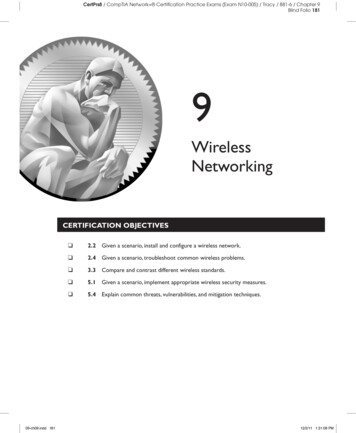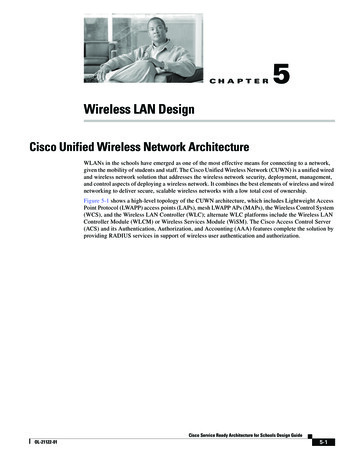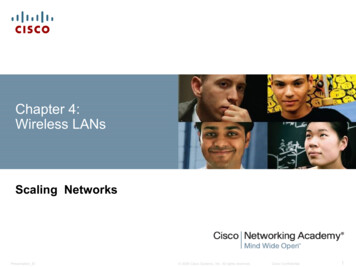
Transcription
Chapter 4:Wireless LANsScaling NetworksPresentation ID 2008 Cisco Systems, Inc. All rights reserved.Cisco Confidential1
Chapter 44.0 Introduction4.1 Wireless LAN Concepts4.2 Wireless LAN Operations4.3 Wireless LAN Security4.4 Wireless LAN Configuration4.5 SummaryPresentation ID 2008 Cisco Systems, Inc. All rights reserved.Cisco Confidential2
Chapter 4: Objectives Describe wireless LAN technology and standards. Describe the components of a wireless LAN infrastructure. Describe wireless topologies. Describe the 802.11 frame structure. Describe the media contention method used by wireless technology. Describe channel management in a WLAN. Describe threats to wireless LANs. Describe wireless LAN security mechanisms. Configure a wireless router to support a remote site. Configure wireless clients to connect to a wireless router. Troubleshoot common wireless configuration issues.Presentation ID 2008 Cisco Systems, Inc. All rights reserved.Cisco Confidential3
4.1 Wireless ConceptsPresentation ID 2008 Cisco Systems, Inc. All rights reserved.Cisco Confidential4
WLAN ComponentsSupporting Mobility Productivity is no longer restricted to a fixed work location or adefined time period. People now expect to be connected at any time and place, fromthe office to the airport or the home. Users now expect to be able to roam wirelessly. Roaming enables a wireless device to maintain Internet accesswithout losing a connection.Presentation ID 2008 Cisco Systems, Inc. All rights reserved.Cisco Confidential5
WLAN ComponentsBenefits of Wireless Increased flexibility Increased productivity Reduced costs Ability to grow and adapt tochanging requirementsPresentation ID 2008 Cisco Systems, Inc. All rights reserved.Cisco Confidential6
WLAN ComponentsWireless TechnologiesWireless networks can be classified broadly as: Wireless personal-area network (WPAN) – Operates in the rangeof a few feet (Bluetooth). Wireless LAN (WLAN) – Operates in the range of a few hundredfeet. Wireless wide-area network (WWAN) – Operates in the range ofmiles. Bluetooth – An IEEE 802.15 WPAN standard; uses a devicepairing process to communicate over distances up to .05 mile(100m). Wi-Fi (wireless fidelity) – An IEEE 802.11 WLAN standard;provides network access to home and corporate users, to includedata, voice and video traffic, to distances up to 0.18 mile (300m).Presentation ID 2008 Cisco Systems, Inc. All rights reserved.Cisco Confidential7
WLAN ComponentsWireless Technologies (cont.) Worldwide Interoperability for Microwave Access (WiMAX) – AnIEEE 802.16 WWAN standard that provides wireless broadbandaccess of up to 30 mi (50 km). Cellular broadband – Consists of various corporate, national, andinternational organizations using service provider cellular access toprovide mobile broadband network connectivity. Satellite Broadband – Provides network access to remote sitesthrough the use of a directional satellite dish.Presentation ID 2008 Cisco Systems, Inc. All rights reserved.Cisco Confidential8
WLAN ComponentsRadio FrequenciesPresentation ID 2008 Cisco Systems, Inc. All rights reserved.Cisco Confidential9
WLAN Components802.11 StandardsPresentation ID 2008 Cisco Systems, Inc. All rights reserved.Cisco Confidential10
WLAN ComponentsWi-Fi CertificationThe Wi-Fi Alliance certifies Wi-Fi and the following productcompatibility: IEEE 802.11a/b/g/n/ac/ad-compatible. IEEE 802.11i secure using WPA2 and Extensible AuthenticationProtocol (EAP) Wi-Fi Protected Setup (WPS) to simplify device connections. Wi-Fi Direct to share media between devices Wi-Fi Passpoint to simplify securely connecting to Wi-Fi hotspotnetworks Wi-Fi Miracast to seamlessly display video between devicesPresentation ID 2008 Cisco Systems, Inc. All rights reserved.Cisco Confidential11
WLAN ComponentsComparing WLANs to LANsPresentation ID 2008 Cisco Systems, Inc. All rights reserved.Cisco Confidential12
Components of WLANsWireless NICsWireless deploymentrequires: End devices withwireless NICs Infrastructure device,such as a wirelessrouter or wireless APPresentation ID 2008 Cisco Systems, Inc. All rights reserved.Cisco Confidential13
Components of WLANsWireless Home RouterA home user typicallyinterconnects wirelessdevices using a small,integrated wirelessrouter.These serve as: access point Ethernet switch routerPresentation ID 2008 Cisco Systems, Inc. All rights reserved.Cisco Confidential14
Components of WLANsBusiness Wireless SolutionsPresentation ID 2008 Cisco Systems, Inc. All rights reserved.Cisco Confidential15
Components of WLANsWireless Access PointsPresentation ID 2008 Cisco Systems, Inc. All rights reserved.Cisco Confidential16
Components of WLANsSmall Wireless Deployment SolutionsPresentation ID 2008 Cisco Systems, Inc. All rights reserved.Cisco Confidential17
Components of WLANsSmall Wireless Deployment Solutions (cont.) Each AP is configuredand managedindividually. This can become aproblem when severalAPs are required.Presentation ID 2008 Cisco Systems, Inc. All rights reserved.Cisco Confidential18
Components of WLANsSmall Wireless Deployment Solutions Support the clustering ofAPs without the use of acontroller. Multiple APs can bedeployed and pushed to asingle configuration to alldevices within the cluster,managing the wirelessnetwork as a singlesystem without worryingabout interferencebetween APs, and withoutconfiguring each AP as aseparate device.Presentation ID 2008 Cisco Systems, Inc. All rights reserved.Cisco Confidential19
Components of WLANsLarge Wireless Deployment Solutions For larger organizations with manyAPs, Cisco provides controller-basedmanaged solutions, including theCisco Meraki Cloud ManagedArchitecture and the Cisco UnifiedWireless Network Architecture. Cisco Meraki cloud architecture is amanagement solution used tosimplify the wireless deployment.Using this architecture, APs arecentrally managed from a controllerin the cloud.Presentation ID 2008 Cisco Systems, Inc. All rights reserved.Cisco Confidential20
Components of WLANsLarge Wireless Deployment Solutions (cont.)Presentation ID 2008 Cisco Systems, Inc. All rights reserved.Cisco Confidential21
Components of WLANsLarge Wireless Deployment Solutions (cont.)Presentation ID 2008 Cisco Systems, Inc. All rights reserved.Cisco Confidential22
Components of WLANsWireless AntennasCisco Aironet APs can use: Omnidirectional Wi-Fi Antennas – Factory Wi-Fi gear often usesbasic dipole antennas, also referred to as “rubber duck” design,similar to those used on walkie-talkie radios. Omnidirectionalantennas provide 360-degree coverage. Directional Wi-Fi Antennas – Directional antennas focus theradio signal in a given direction, which enhances the signal to andfrom the AP in the direction the antenna is pointing. Yagi antennas – Type of directional radio antenna that can beused for long-distance Wi-Fi networking.Presentation ID 2008 Cisco Systems, Inc. All rights reserved.Cisco Confidential23
802.11 WLAN Topologies802.11 Wireless Topology ModesPresentation ID 2008 Cisco Systems, Inc. All rights reserved.Cisco Confidential24
802.11 WLAN Topologies802.11 Wireless Topology Modes (cont.)Presentation ID 2008 Cisco Systems, Inc. All rights reserved.Cisco Confidential25
802.11 WLAN TopologiesAd Hoc ModeTethering (personal hotspot) – Variation of the Ad Hoc topologywhen a smart phone or tablet with cellular data access is enabled tocreate a personal hotspot.Presentation ID 2008 Cisco Systems, Inc. All rights reserved.Cisco Confidential26
802.11 WLAN TopologiesInfrastructure ModePresentation ID 2008 Cisco Systems, Inc. All rights reserved.Cisco Confidential27
802.11 WLAN TopologiesInfrastructure Mode (cont.)Presentation ID 2008 Cisco Systems, Inc. All rights reserved.Cisco Confidential28
4.2 Wireless LAN OperationsPresentation ID 2008 Cisco Systems, Inc. All rights reserved.Cisco Confidential29
802.11 Frame StructureWireless 802.11 FramePresentation ID 2008 Cisco Systems, Inc. All rights reserved.Cisco Confidential30
802.11 Frame StructureWireless 802.11 FramePresentation ID 2008 Cisco Systems, Inc. All rights reserved.Cisco Confidential31
802.11 Frame StructureFrame Control FieldPresentation ID 2008 Cisco Systems, Inc. All rights reserved.Cisco Confidential32
802.11 Frame StructureWireless Frame TypePresentation ID 2008 Cisco Systems, Inc. All rights reserved.Cisco Confidential33
802.11 Frame StructureManagement FramesPresentation ID 2008 Cisco Systems, Inc. All rights reserved.Cisco Confidential34
802.11 Frame StructureControl FramesPresentation ID 2008 Cisco Systems, Inc. All rights reserved.Cisco Confidential35
Wireless OperationCSMA/CACSMA/CA FlowchartPresentation ID 2008 Cisco Systems, Inc. All rights reserved.Cisco Confidential36
Wireless OperationWireless Clients and Access Point AssociationPresentation ID 2008 Cisco Systems, Inc. All rights reserved.Cisco Confidential37
Wireless OperationAssociation Parameters SSID – Unique identifier that wireless clients use to distinguishbetween multiple wireless networks in the same vicinity. Password – Required from the wireless client to authenticate to theAP. Sometimes called the security key. Network mode – Refers to the 802.11a/b/g/n/ac/ad WLANstandards. APs and wireless routers can operate in a mixed mode;i.e., it can simultaneously use multiple standards. Security mode – Refers to the security parameter settings, such asWEP, WPA, or WPA2. Channel settings – Refers to the frequency bands used to transmitwireless data. Wireless routers and AP can choose the channelsetting or it can be manually set.Presentation ID 2008 Cisco Systems, Inc. All rights reserved.Cisco Confidential38
Wireless OperationDiscovering APsPassive mode AP advertises its service by sending broadcast beacon framescontaining the SSID, supported standards, and security settings. The beacon’s primary purpose is to allow wireless clients to learnwhich networks and APs are available in a given area.Active mode Wireless clients must know the name of the SSID. Wireless client initiates the process by broadcasting a probe requestframe on multiple channels. Probe request includes the SSID name and standards supported. May be required if an AP or wireless router is configured to notbroadcast beacon frames.Presentation ID 2008 Cisco Systems, Inc. All rights reserved.Cisco Confidential39
Wireless OperationAuthentication Open authentication – ANULL authentication wherethe wireless client says“authenticate me” and the APresponds with “yes.” Usedwhere security is of noconcern. Shared key authentication –Technique is based on a keythat is pre-shared betweenthe client and the AP.Presentation ID 2008 Cisco Systems, Inc. All rights reserved.Cisco Confidential40
Channel ManagementFrequency Channel SaturationDirect-sequence spread spectrum (DSSS) Uses spread-spectrum modulation technique; designed to spread asignal over a larger frequency band making it more resistant tointerference. Used by 802.11b.Frequency-hopping spread spectrum (FHSS) Relies on spread-spectrum methods to communicate. Transmits radio signals by rapidly switching a carrier signal amongmany frequency channels. This channel-hopping process allows for a more efficient usage ofthe channels, decreasing channel congestion. Used by the original 802.11 standard.Presentation ID 2008 Cisco Systems, Inc. All rights reserved.Cisco Confidential41
Channel ManagementFrequency Channel Saturation (cont.)Orthogonal Frequency-Division Multiplexing (OFDM) Subset of frequency division multiplexing in which a single channelutilizes multiple subchannels on adjacent frequencies. Because OFDM uses subchannels, channel usage is very efficient. Used by a number of communication systems, including802.11a/g/n/ac.Presentation ID 2008 Cisco Systems, Inc. All rights reserved.Cisco Confidential42
Channel ManagementSelecting ChannelsPresentation ID 2008 Cisco Systems, Inc. All rights reserved.Cisco Confidential43
Channel ManagementSelecting Channels (cont.)The solution to 802.11b interference is to usenonoverlapping channels 1, 6, and 11.Presentation ID 2008 Cisco Systems, Inc. All rights reserved.Cisco Confidential44
Channel ManagementSelecting Channels (cont.)Use channels in the larger, less-crowded 5 GHz band,reducing “accidental denial of service (DoS),” this band cansupport four non-overlapping channels.Presentation ID 2008 Cisco Systems, Inc. All rights reserved.Cisco Confidential45
Channel ManagementSelecting Channels (cont.)Channel bonding combines two 20-MHz channels into one40-MHz channel.Presentation ID 2008 Cisco Systems, Inc. All rights reserved.Cisco Confidential46
Channel ManagementPlanning a WLAN Deployment If APs are to use existingwiring, or if there arelocations where APscannot be placed, notethese locations on themap. Position APs aboveobstructions. Position APs verticallynear the ceiling in thecenter of each coveragearea, if possible. Position APs in locationswhere users are expectedto be.Presentation ID 2008 Cisco Systems, Inc. All rights reserved.Cisco Confidential47
4.3 Wireless LAN SecurityPresentation ID 2008 Cisco Systems, Inc. All rights reserved.Cisco Confidential48
WLAN ThreatsSecuring WirelessPresentation ID 2008 Cisco Systems, Inc. All rights reserved.Cisco Confidential49
WLAN ThreatsDoS AttackWireless DoS attacks can be the result of: Improperly configured devices. Configuration errors can disable the WLAN. A malicious user intentionally interfering with the wirelesscommunication. Disable the wireless network where no legitimatedevice can access the medium.Accidental interference WLANs operate in the unlicensed frequency bands and are prone tointerference from other wireless devices. May occur from such devices as microwave ovens, cordless phones,baby monitors, and more. 2.4 GHz band is more prone to interference than the 5 GHz band.Presentation ID 2008 Cisco Systems, Inc. All rights reserved.Cisco Confidential50
WLAN ThreatsManagement Frame DoS AttacksA spoofed disconnect attack Occurs when an attacker sends a series of “disassociate”commands to all wireless clients. Cause all clients to disconnect. The wireless clients immediately try to re-associate, which createsa burst of traffic.A CTS flood An attacker takes advantage of the CSMA/CA contention methodto monopolize the bandwidth. The attacker repeatedly floods Clear to Send (CTS) frames to abogus STA. All wireless clients sharing the RF medium receive the CTS andwithhold transmissions until the attacker stops transmitting theCTS frames.Presentation ID 2008 Cisco Systems, Inc. All rights reserved.Cisco Confidential51
WLAN ThreatsRogue Access PointsA rogue AP is an AP or wireless router that has been: Connected to a corporate network without explicit authorizationand against corporate policy. Connected or enabled by an attacker to capture client data, suchas the MAC addresses of clients (both wireless and wired), or tocapture and disguise data packets, to gain access to networkresources, or to launch man-in-the-middle (MITM) attacks. To prevent the installation of rogue APs, organizations must usemonitoring software to actively monitor the radio spectrum forunauthorized APs.Presentation ID 2008 Cisco Systems, Inc. All rights reserved.Cisco Confidential52
WLAN ThreatsMan-in-the-Middle Attack“Evil twin AP” attack: A popular wireless MITM attack where an attacker introduces arogue AP and configures it with the same SSID as a legitimate AP. Locations offering free Wi-Fi, such as airports, cafes, andrestaurants, are hotbeds for this type of attack due to the openauthentication. Connecting wireless clients would see two APs offering wirelessaccess. Those near the rogue AP find the stronger signal and mostlikely associate with the evil twin AP. User traffic is now sent to therogue AP, which in turn captures the data and forwards it to thelegitimate AP. Return traffic from the legitimate AP is sent to the rogue AP,captured, and then forwarded to the unsuspecting STA.Presentation ID 2008 Cisco Systems, Inc. All rights reserved.Cisco Confidential53
Securing WLANsWireless Security OverviewUse authentication and encryption to secure a wireless network.Presentation ID 2008 Cisco Systems, Inc. All rights reserved.Cisco Confidential54
Securing WLANsShared Key Authentication MethodsPresentation ID 2008 Cisco Systems, Inc. All rights reserved.Cisco Confidential55
Securing WLANsEncryption MethodsIEEE 802.11i and the Wi-Fi Alliance WPA and WPA2 standards usethe following encryption protocols: Temporal Key Integrity Protocol (TKIP) Used by WPA. Makes use of WEP, but encrypts the Layer 2 payload usingTKIP, and carries out a Cisco Message Integrity Check (MIC). Advanced Encryption Standard (AES) Encryption method used by WPA2. Preferred method because it aligns with the industry standardIEEE 802.11iA. Stronger method of encryption. Uses the Counter Cipher Mode with Block Chaining MessageAuthentication Code Protocol (CCMP). Always choose WPA2 with AES when possible.Presentation ID 2008 Cisco Systems, Inc. All rights reserved.Cisco Confidential56
Securing WLANsAuthenticating a Home UserWPA and WPA2 support two types of authentication: Personal Intended for home or small office networks, or authenticatedusers who use a pre-shared key (PSK). No special authentication server is required. Enterprise Requires a Remote Authentication Dial-In User Service(RADIUS) authentication server. Provides additional security. Users must authenticate using 802.1X standard, which usesthe Extensible Authentication Protocol (EAP) forauthentication.Presentation ID 2008 Cisco Systems, Inc. All rights reserved.Cisco Confidential57
Securing WLANsAuthentication in the EnterpriseEnterprise security mode choices require an Authentication,Authorization,and Accounting (AAA) RADIUS server.Presentation ID 2008 Cisco Systems, Inc. All rights reserved.Cisco Confidential58
8.4 Wireless LAN ConfigurationPresentation ID 2008 Cisco Systems, Inc. All rights reserved.Cisco Confidential59
Configure a Wireless RouterConfiguring a Wireless RouterBefore installing a wireless router, consider the following settings:Presentation ID 2008 Cisco Systems, Inc. All rights reserved.Cisco Confidential60
Configure a Wireless RouterConfiguring a Wireless RouterAn Implementation Plan consists of the following steps:Step 1. Start the WLAN implementation process with a single AP anda single wireless client, without enabling wireless security.Step 2. Verify that the client has received a DHCP IP address and canping the local, wired default router, and then browse to theexternal Internet.Step 3. Configure wireless security using WPA2/WPA Mixed Personal.Never use WEP unless no other options exist.Step 4. Back up the configuration.Presentation ID 2008 Cisco Systems, Inc. All rights reserved.Cisco Confidential61
Configure a Wireless RouterSet Up and Install the Linksys EAS6500.Presentation ID 2008 Cisco Systems, Inc. All rights reserved.Cisco Confidential62
Configure a Wireless RouterConfiguring a Linksys Smart Wi-Fi HomepagePresentation ID 2008 Cisco Systems, Inc. All rights reserved.Cisco Confidential63
Configure a Wireless RouterSmart Wi-Fi SettingsSmart Wi-Fi settings enable you to: Configure the router’s basic settings for the local network. Diagnose and troubleshoot connectivity issues on the network. Secure and personalize the wireless network. Configure the DMZ feature, view connected computers and deviceson the network, and set up port forwarding.Presentation ID 2008 Cisco Systems, Inc. All rights reserved.Cisco Confidential64
Configure a Wireless RouterSmart Wi-Fi Tools Device List – Lists who is connected to the WLAN. Personalizedevice names and icons. Connect devices. Guest Access – Creates a separate network for up to 50 guests athome while keeping network files safe with the Guest Access Tool. Parental Controls – Protects kids and family members byrestricting access to potentially harmful websites Media Prioritization – Prioritizes bandwidth to specific devices andapplications. Speed Test – Tests the upload and download speed of the Internetlink. Useful for baselining. USB Storage – Controls access to shared files.Presentation ID 2008 Cisco Systems, Inc. All rights reserved.Cisco Confidential65
Configure a Wireless RouterBacking Up a ConfigurationTo back up the configuration with the Linksys EA6500 wireless router,perform the following steps:Step 1. Log in to the Smart Wi-Fi Home page. Clickthe Troubleshooting icon to display the TroubleshootingStatus window.Step 2. Click the Diagnostic tab to open the DiagnosticTroubleshooting window.Step 3. Under the Router configuration title, click Backup and savethe file to an appropriate folder.Presentation ID 2008 Cisco Systems, Inc. All rights reserved.Cisco Confidential66
Configuring Wireless ClientsConnecting Wireless Clients After the AP or wireless router has been configured, the wirelessNIC on the client must be altered to allow it to connect to theWLAN. The user should verify that the client has successfully connectedto the correct wireless network, because there may be manyWLANs available with which to connect.Presentation ID 2008 Cisco Systems, Inc. All rights reserved.Cisco Confidential67
Troubleshoot WLAN IssuesTroubleshooting ApproachesThree main troubleshooting approaches used to resolve networkproblems: Bottom-up – Start at Layer 1 and work up. Top-down – Start at the top layer and work down. Divide-and-conquer – Ping the destination. If the pings fail,verify the lower layers. If the pings are successful, verify theupper layers.Presentation ID 2008 Cisco Systems, Inc. All rights reserved.Cisco Confidential68
Troubleshoot WLAN IssuesWireless Client Not ConnectingPresentation ID 2008 Cisco Systems, Inc. All rights reserved.Cisco Confidential69
Troubleshoot WLAN IssuesTroubleshooting When the Network Is SlowPresentation ID 2008 Cisco Systems, Inc. All rights reserved.Cisco Confidential70
Troubleshoot WLAN IssuesUpdating FirmwarePresentation ID 2008 Cisco Systems, Inc. All rights reserved.Cisco Confidential71
Chapter 4: Summary WLANs are often implemented in homes, offices, and campusenvironments. Only the 2.4, GHz, 5.0 GHz, and 60 GHz frequencies are used for802.11 WLANs. The ITU-R regulates the allocation of the RF spectrum, while IEEEprovides the 802.11 standards to define how these frequencies areused for the physical and MAC sub-layer of wireless networks. The Wi-Fi Alliance certifies that vendor products conform to industrystandards and norms. A STA uses a wireless NIC to connect to an infrastructure devicesuch as a wireless router or wireless AP. STAs connect using an SSID. APs can be implemented as standalone devices, in small clusters, orin a larger controller-based network.Presentation ID 2008 Cisco Systems, Inc. All rights reserved.Cisco Confidential72
Chapter 4: Summary (cont.) A Cisco Aironet AP can use an onmidirectional antenna, a directionalantenna, or a yagi antenna to direct signals. IEEE 802.11n/ac/ad use MIMO technology to improve throughputand support up to four antennas, simultaneously. In ad-hoc mode or IBSS, two wireless devices connect to each otherin a P2P manner. In infrastructure mode, APs connect to network infrastructure usingthe wired DS. Each AP defines a BSS and is uniquely identified by its BSSID. Multiple BSSs can be joined into an ESS. Using a particular SSID in an ESS provides seamless roamingcapabilities among the BSSs in the ESS.Presentation ID 2008 Cisco Systems, Inc. All rights reserved.Cisco Confidential73
Chapter 4: Summary (cont.) Additional SSIDs can be used to segregate the level of networkaccess defined by which SSID is in use. An STA first authenticates with an AP, and then associates with thatAP. The 802.11i/WPA2 authentication standard should be used. Use theAES encryption method with WPA2. When planning a wireless network, nonoverlapping channels shouldbe used when deploying multiple APs to cover a particular area.There should be a 10–15 percent overlap between BSAs in an ESS. Cisco APs support PoE to simplify installation. Wireless networks are specifically susceptible to threats such aswireless intruders, rogue APs, data interception, and DoS attacks.Cisco has developed a range of solutions to mitigate against thesetypes of threats.Presentation ID 2008 Cisco Systems, Inc. All rights reserved.Cisco Confidential74
Presentation ID 2008 Cisco Systems, Inc. All rights reserved.Cisco Confidential75
Wireless Operation Association Parameters SSID - Unique identifier that wireless clients use to distinguish between multiple wireless networks in the same vicinity. Password - Required from the wireless client to authenticate to the AP. Sometimes called the security key. Network mode - Refers to the 802.11a/b/g/n/ac/ad WLAN standards.




